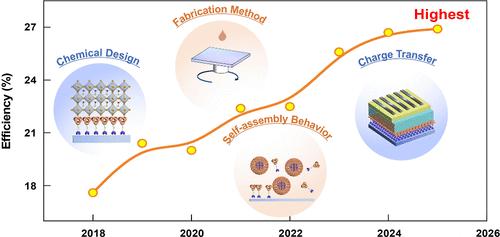自组装单层:革新p-i-n钙钛矿太阳能电池
IF 18.2
1区 材料科学
Q1 CHEMISTRY, PHYSICAL
引用次数: 0
摘要
自组装单层(SAMs)已经成为一种革命性的空孔传输材料,用于倒钙钛矿太阳能电池(PSCs),其特点是可以忽略不计的寄生吸收,溶液可加工的简单性和破纪录的设备效率。然而,由于对透明导电氧化物(tco)- sam -钙钛矿相互作用的机理认识不足,诸如溶剂诱导的分子聚集、界面能失配和操作稳定性限制等挑战仍然存在。本文系统地追溯了sam的进化过程,探索了它们的分子水平功能,并研究了它们的自组装机制及其在psc中的多种应用。我们阐明了分子结构如何影响器件性能和稳定性,强调了sam在效率提高和耐用性改善方面的双重作用。最后,我们提出了有针对性的研究方向,以解决当前的局限性,加快基于sam的psc的可扩展应用。本文章由计算机程序翻译,如有差异,请以英文原文为准。

Self-Assembled Monolayer: Revolutionizing p-i-n Perovskite Solar Cells
Self-assembled monolayers (SAMs) have emerged as a transformative class of hole transport materials for inverted perovskite solar cells (PSCs), distinguished by their negligible parasitic absorption, solution-processable simplicity, and record-breaking device efficiencies. However, challenges still remain such as solvent-induced molecular aggregation, interfacial energy mismatch, and operational stability limitations, which originate fundamentally from insufficient mechanistic understanding of transparent conductive oxides (TCOs)-SAM-perovskite interactions. This review systematically traces the evolution of SAMs, explores their molecular-level functionalities, and examines their self-assembly mechanisms and diverse applications in PSCs. We clarify how molecular structures influence device performance and stability, highlighting SAMs’ dual role in efficiency enhancement and durability improvement. Finally, we propose targeted research directions to address current limitations and accelerate the scalable application of SAM-based PSCs.
求助全文
通过发布文献求助,成功后即可免费获取论文全文。
去求助
来源期刊

ACS Energy Letters
Energy-Renewable Energy, Sustainability and the Environment
CiteScore
31.20
自引率
5.00%
发文量
469
审稿时长
1 months
期刊介绍:
ACS Energy Letters is a monthly journal that publishes papers reporting new scientific advances in energy research. The journal focuses on topics that are of interest to scientists working in the fundamental and applied sciences. Rapid publication is a central criterion for acceptance, and the journal is known for its quick publication times, with an average of 4-6 weeks from submission to web publication in As Soon As Publishable format.
ACS Energy Letters is ranked as the number one journal in the Web of Science Electrochemistry category. It also ranks within the top 10 journals for Physical Chemistry, Energy & Fuels, and Nanoscience & Nanotechnology.
The journal offers several types of articles, including Letters, Energy Express, Perspectives, Reviews, Editorials, Viewpoints and Energy Focus. Additionally, authors have the option to submit videos that summarize or support the information presented in a Perspective or Review article, which can be highlighted on the journal's website. ACS Energy Letters is abstracted and indexed in Chemical Abstracts Service/SciFinder, EBSCO-summon, PubMed, Web of Science, Scopus and Portico.
 求助内容:
求助内容: 应助结果提醒方式:
应助结果提醒方式:


